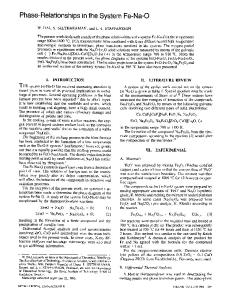Phase relationships in the Fe-Cr-Ni system at solidification temperatures
- PDF / 978,271 Bytes
- 10 Pages / 612 x 828 pts Page_size
- 70 Downloads / 328 Views
I.
INTRODUCTION
A major class of corrosion-resistant alloys has the ironrich corner of the Fe-Cr-Ni system as its compositional base. Stainless steels, for example, range typically from 20 to 40 wt pct of nickel plus chromium. Technical understanding of the solidification of many alloys based on this ternary system is extensive. However, our knowledge of the phase relationships and compositions for equilibria among the liquid, delta, and gamma phases for the ironcomer of the system is still limited. Since the primary phases that precipitate during solidification are solution phases, segregation of solute species can occur. Nonetheless, at solidification rates normally employed in producing castings, the composition path of an alloy will be between thermodynamically imposed limits. 12' These two broad sets of limits are (a) that the path for the system follows the dictates of equilibrium completely, and (b) that equilibrium is followed only at the solidification front. In the latter case, where there is no diffusion in the solid phase and complete mixing in the liquid phase, the solidification process corresponds to precipitation of the solid from a closed system. A thermodynamic analysis of the solidification process requires knowledge of the topological features of the phase diagram of the system as well as the partition ratio between the liquid and each solid-solution phase. The partition ratios for each of the primary phases that co-precipitate from the liquid phase may also have to be known. This analysis is facilitated by employing a thermodynamic model for each of the participating phases of the system which is reliD.M. KUNDRAT is Senior Staff Engineer, Armco Inc., Middletown, OH 45043 and Adjunct Professor, Department of Materials Science and Engineering, University of Cincinnati, Cincinnati, OH 45221. J.F. ELLIOTT is Professor of Metallurgy, Department of Materials Science and Engineering, Massachusetts Institute of Technology, Cambridge, MA 02139. Manuscript submitted February 10, 1987.
METALLURGICALTRANSACTIONS A
able for interpolating among the experimental information obtained. The present study is a part of a larger investigation of the phase relationships of the Fe-Cr-Ni-C system. 3 The primary focus of the investigation has been the experimental determination and modeling of the tie-lines employing the experimental data from which the topological features of the phase diagram and the partition ratios of elements between sets of phases are deduced. Although results from a number of earlier studies are available for the iron-rich FeCr-Ni system, additional measurements were made mainly as a check on the experimental and modeling methods employed in the larger study. Also, the liquidus surface for the gamma phase in the ternary system was studied because the contours of the liquidus isotherms deduced by earlier investigators are in conflict. The matter will be discussed in more detail later in this paper.
II.
PREVIOUS MEASUREMENTS
A. Unary Systems Fe, Cr, and Ni Table I lists the equilibrium tran
Data Loading...











